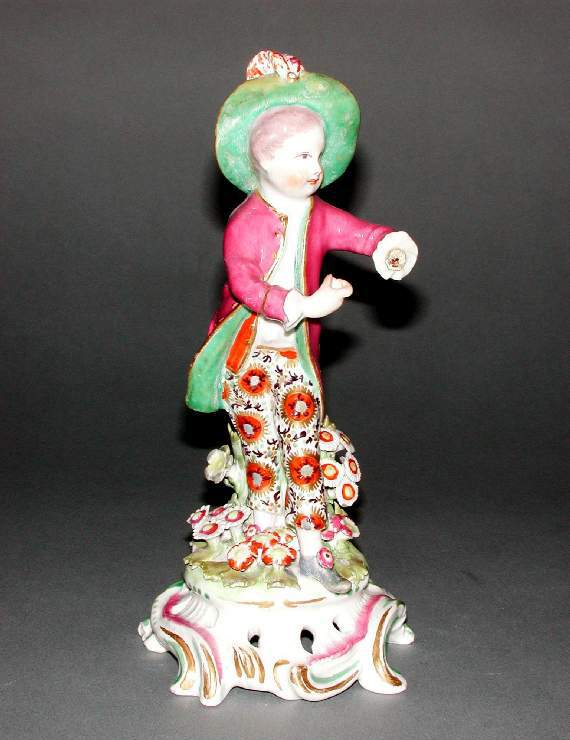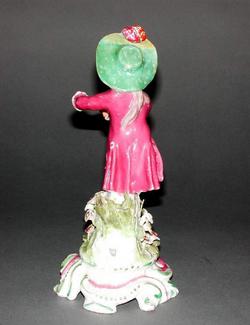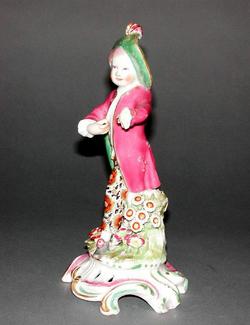Current Location: In storage
Titles
Dancing Boy, one of the 'New Dancers'
Maker(s)
Factory:
Bow Porcelain Manufactory
Entities
Categories
Description
Soft-paste porcelain containing bone ash, figure of a Dancing Boy, press-moulded, with hand-modelled details, painted over very slightly turquoise-tinted lead-glaze in polychrome enamels, and gilt.
Soft-paste porcelain containing bone ash, figure of a Dancing Boy, press-moulded, with hand-modelled details, painted over very slightly turquoise-tinted lead-glaze in greyish-blue, yellowish-green, bluish-green, yellow, pink, flesh-pink, orange-red, dark purple, pale brown, and grey enamels, and gilt. The glazed concave underside has a ventilation hole under the figure. The circular base has incurved sides with six kidney-shaped holes in the front, and a scrolled edge forming five low supports. It rises up at the back into a tree stump with a small triangular hole at its base, a few applied leaves higher up, and flowers and leaves on each side. The boy stands on his right leg with his left leg forward, holding both arms curved round in front of him. He has long pale brown hair, and a bluish-green hat with a red and pink feather attached to the turned back brim at the front. He wears a white shirt, an orange-red waistcoat with gold buttons, a pink coat with a green lining, gold edges and buttons; trousers with a red, purple and gold floral pattern; and blue shoes with a pink flower on top. There are three groups of applied flowers and leaves at his feet. The base is picked out in pink, turquoise, and gold.
Legal notes
Bequeathed by Cecil E. Byas
Measurements and weight
Height: 18.9 cm
Width: 9.0 cm
Acquisition and important dates
Method of acquisition: Bequeathed
(1938)
by
Byas, Cecil E.
Dating
18th Century, third quarter
George III
Circa
1760
-
1765
School or Style
Rococo
People, subjects and objects depicted
Components of the work
Decoration
composed of
enamels
( greyish-blue, yellowish-green, bluish-green, yellow, pink, flesh-pink, orange-red, dark purple, pale brown, and grey)
gold
Details
Materials used in production
presumed lead
Lead-glaze
presumed phosphatic
Soft-paste porcelain
Techniques used in production
Press-moulding
: Soft-paste porcelain containing bone ash, press-moulded, with hand-modelled details, painted over very slightly turquoise-tinted lead-glaze in polychrome enamels, and gilt
Glazing (coating)
References and bibliographic entries
Identification numbers
Accession number: EC.10-1938
Primary reference Number: 42036
Stable URI
Audit data
Created: Saturday 6 August 2011
Updated: Tuesday 30 April 2024
Last processed: Thursday 14 August 2025
Associated departments & institutions
Owner or interested party:
The Fitzwilliam Museum
Associated department:
Applied Arts






